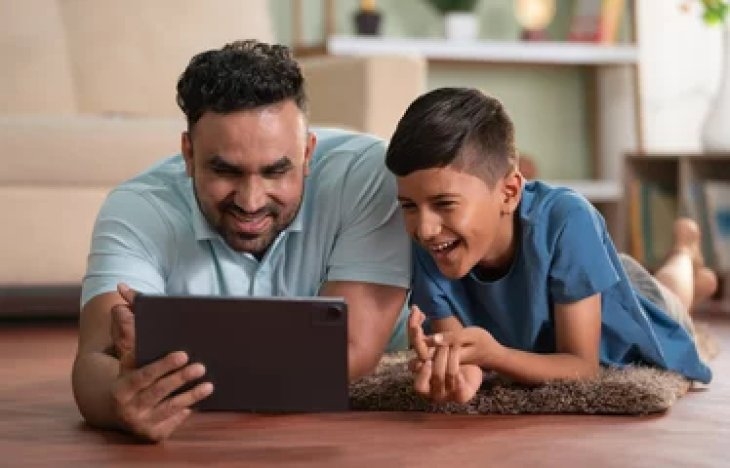Remember when your parents would warn you that too much television would make your eyes turn square?
While this may be just a myth, there are certainly a number of very real impacts that can result from spending too much time in front of a screen. For children and adults alike, understanding how to navigate time engaging with screens is a crucial part of managing everyday health and wellbeing.
With the increasing prevalence of screens, limiting the time we spend on them is becoming more challenging. For many of us, activities that may have previously taken place in person, including work meetings or social events, may now take place via a screen-based interaction. Screens can offer convenience, connectivity, access, and entertainment – but it’s also important for us to navigate the potential downsides of too much screen time on both an individual and a societal level.
What are the physical effects of too much screen time?
Spending a significant amount of time in front of a screen (whether that’s a computer, phone, tablet, or TV) can have negative impacts on our physical health, with issues including:
- Dry eyes
- Headaches
- Blurry vision
- Posture or musculoskeletal issues
- Disrupted circadian rhythms (as a result of the blue screen emitted from screens)
Some of these symptoms can be shaken off by choosing to engage in a new activity, but with prolonged exposure, the risk of ongoing physical impact continues to rise.
Melissa Pandika, writing for Rally Health, says ‘staring into a screen for extended periods of time can cause “computer vision syndrome”. You’re probably familiar with the symptoms: strained, dry eyes, blurred vision, and headaches.’ If you’re a regular screen user, understanding the signs of computer vision syndrome is one way you can proactively take frequent breaks, supporting your physical health throughout your screen time.
The mental and emotional impacts of increasing screen time
Alongside the physical impacts of too much screen time, you may also experience negative mental and emotional impacts that can be detrimental to your overall health and wellbeing.
Our use of screens to socially connect with others can offer something of a paradox: while we’re able to reach more people than ever before through technological tools, feelings of isolation and loneliness can also coincide with our screen usage. In a 2023 Psychology Today article, this paradoxical relationship is explored: ‘When the internet is used as a way-station on the route to enhancing existing relationships and forging new social connections, it is a useful tool for reducing loneliness.’ It goes on, however, to state that ‘when social technologies are used to escape the social world… feelings of loneliness escalate.’
When time spent online begins to replace the time we may otherwise spend in the real world with our friends and family members, this can increase our experience of loneliness. By opting to protect our physical social experiences, we can reduce the risk of isolation or negative mental health impacts, ensuring we’re creating a balance between the time we spend connecting online and the time we spend connecting with those we love in person.
How increasing screen time can impact our brains
Spending time in a screen-based environment may feel like it’s increasing our productivity. In reality, however, spending too much time jumping between screens can actually reduce our attention spans, creating an inability to focus and a decrease in our cognitive performance.
If you’ve ever felt like you needed to jump from screen to screen, you’re not alone. ‘Screen time overloads the sensory system, fractures attention, and depletes mental reserves,’ states Victoria L. Dunckley, author of Reset Your Child’s Brain. ‘When attention suffers, so does the ability to process one’s internal and external environment, so little demands become big ones. By depleting mental energy with high visual and cognitive input, screen time contributes to low reserves.’
This is of particular importance to those who may be working or studying in an online, screen-based environment. By carefully considering how this time is spent, you can protect your brain from the risk of over-stimulation and the resulting drain on your mental abilities.
How we can better manage our screen time
The power of our online worlds can offer us opportunities for learning, development, connection, and discovery – but without careful management, too much screen time can be damaging.
By adopting some careful management strategies, we can each make the most of the time we spend on our screens, while reducing the risk of ongoing harm.
These strategies include:
- Creating defined boundaries. This strategy can be used for both adults and children. By creating designated times when screens are in use, or device-free zones in your home, you can build healthier habits with more conscientious screen consumption.
- Making the most of screen time tracking apps. There’s a wide range of apps available that track your screen time across all devices, providing key insights not only across your screen time in general, but your usage categories. These apps can be a great way to build more visibility across your screen habits, helping you to set clear boundaries that are personalised to your unique needs.
- Embrace digital detox days. Is there a day a week you can disconnect from screens? Even a single hour a day that’s screen-free can give you an opportunity to chat with friends and family, enjoy the outdoors, or spend time on a hobby.
- Build a digital decluttering routine. In the same way we occasionally need to declutter our homes, a digital declutter can be freeing and empowering. Regularly take stock of the way you use screens, deleting any unnecessary apps, unsubscribing from emails you no longer need to receive, and deleting files you’re finished with.
Conclusion
The use of screens isn’t something we need to be afraid of if we’re willing to build healthy boundaries, grow our awareness of their risks, and create consistent routines that support our overall health and wellbeing. By finding the right balance between technology’s benefits and the need we have for physical moments of connection and engagement, we can find an approach that’s personalised, sustainable, and mindful. Whether it’s a digital detox once a week, a technology-free zone in your home, or building more regular social activities with friends and family, there are many different ways you can reduce your screen time without sacrificing your priorities.
One way you can reduce your screen time is by getting out and about in your community. Share a lunch with old and new friends at one of our Lifestyle Lunches, or become an Enhanced Lifestyles member to access exclusive events, experiences, and information sessions. Our jam-packed events calendar is just one of the ways we enhance the lifestyles of our wonderful customers.







